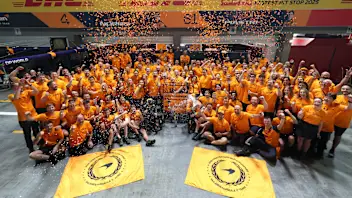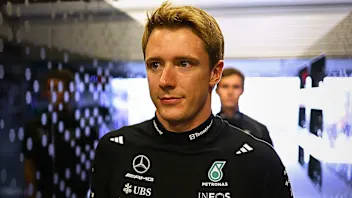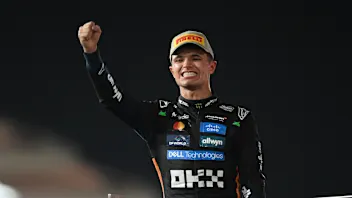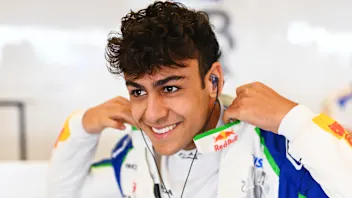Formula One racing's greatest title showdowns
Since its maiden season, when three drivers headed into the last race in contention for the world championship crown, Formula One racing has thrown up no shortage of dramatic, shocking, even infamous final-round title deciders.
With Lewis Hamilton and Nico Rosberg set to add to that legacy in Abu Dhabi next weekend, we present 10 of the most memorable F1 showdowns, encompassing outsider upsets, controversial collisions and the most consummate of title-clinching victories...
New F1 era opens with a three-way classic - Italy, 1950
Drivers: Nino Farina (champion), Juan Manuel Fangio and Luigi Fagioli
The inaugural Formula One world championship ended in style, as the 1950 drivers’ title came down to a three-way fight at Monza. Alfa Romeo had steamrollered the opposition over the seven-race calendar, and it was their ‘three Fs’ in contention: Juan Manuel Fangio, Nino Farina and Luigi Fagioli. Fangio held the points advantage on 26, two ahead of Fagioli and four clear of Farina. The latter, along with Fangio, was given the new, more powerful 159 model for the Italian finale, and the pair duly locked out the front row - with Fagioli, still in the 158, in fifth. Farina led early on, but was hounded by Fangio until a quarter distance, when the race turned decisively - Fangio retired with gearbox trouble, and though he would rejoin in team mate Piero Taruffi’s Alfa, he would suffer further issues. With Fangio out of the picture and Fagioli a distant third, Farina wrapped up victory to become the first champion in Formula One history.
Brabham wins at a push - USA, 1959
Jack Brabham (champion), Stirling Moss and Tony Brooks
Nine years on and once again three drivers headed into the final round with a chance of winning the title. John Arthur ‘Jack’ Brabham led the standings, but it was Moss - like Brabham driving a Cooper T51, although not for the works team - who had the momentum, having triumphed in the previous two Grands Prix to close to within 5.5 points of Brabham. Brooks, meanwhile, had kept Ferrari in touch with the Cooper duo, but needed results to fall his way in order to prevail. Moss claimed the early initiative, converting pole into an early lead, but suffered heartbreak as a mechanical failure forced him to retire. With Brooks pitting after a first-lap altercation, Brabham - now flanked by young team mate Bruce McLaren - had the race, and the title, seemingly wrapped up. There was a last moment of drama, however. On the final lap he ran out of fuel, slowing to a stop. After waving McLaren through, Brabham pushed his car over the line to finish fourth - enough for him to become the first Australian world champion.
The unprecedented double - Mexico, 1964
John Surtees (champion), Graham Hill and Jim Clark
In terms of sheer drama, 1964 takes some beating. BRM’s Graham Hill led the championship on 39 points arriving in Mexico, but knew he would have to drop points if he scored again. Ferrari’s Surtees was second, on 34, while Lotus’s Clark had won more races than his rivals but needed to triumph again if he was to snatch the title - a slim hope, but one that looked decidedly better as he took a dominant pole and then an early lead. Surtees and Hill both soon hit trouble and slipped down the order but were able to fight their way back, with Hill quickly up to a vital third - which would have guaranteed him the crown. On lap 31, however, he and Lorenzo Bandini collided, with the damage all but ending his title hopes, which now depended on both Clark and Surtees not scoring. The latter had moved up to third in Hill’s absence, but that wasn’t enough: Clark, still leading, was heading for a second drivers’ championship. Seven laps from the finish, however, the race swung again, as Clark’s Lotus began leaking oil. Two laps from the end he lost the lead; one lap from the finish and his engine seized - Clark was out. Surtees had slipped behind his team mate Bandini, but the latter duly moved aside in order for the former motorcycle champion to finish second and make history as the first - and to date only - driver to win world championships on two and four wheels.
The storm after the storm - Japan, 1976
James Hunt (champion) and Niki Lauda
There were few hints in the early races of 1976 that this would be one of the most dramatic, turbulent and intense seasons. Ferrari’s Niki Lauda stormed to four wins and six podiums in the opening six races to take an early stranglehold on the title. It was an advantage he retained - even after rancour, controversy and penalties at Jarama and Silverstone - heading to the Nurburgring, the 10th race in a 16-round calendar. What transpired has become part of F1 folklore: Lauda crashed heavily and was engulfed by smoke and flames, leaving him fighting for his life. But despite being read his last rites, the Austrian made an astonishing recovery: not only did he survive, staggeringly he competed - and finished fourth - at Monza barely a month later. McLaren’s James Hunt had won two of the three races during Lauda’s recuperation, and triumphed twice more before the Fuji finale. Lauda had managed to stay ahead in the standings, but his once-imperious lead had been slashed to just three points. The drama only intensified once they reached Japan: atrocious conditions meant debate raged over whether the race should even go ahead. Lauda, who had protested before the start, pulled out after one lap, as did Emerson Fittipaldi and Carlos Pace. Hunt led almost throughout, before he suffered a late puncture that forced him to pit and dropped him to fifth. It meant Lauda was still headed for the title. But two laps from the chequered flag, Hunt passed Alan Jones and Clay Regazzoni to secure third and beat Lauda to the crown by just one point.
Settled by the smallest of margins - Portugal, 1984
Niki Lauda (champion) and Alain Prost
This time Lauda was on the winning side of an epic showdown, as he beat new McLaren team mate Alain Prost to the title by just half a point - the smallest margin in F1 history. Prost had set the early pace in the season and was ahead after eight of the 16 races, but Lauda hit back, winning three times and finishing second twice in the space of five races to leapfrog the Frenchman. Prost won the penultimate race, meaning just 3.5 points - the half deriving from a Monaco race halted after 31 laps - separated him and Lauda heading into the finale at Estoril. Prost did all he could, securing a front-row start and leading from the ninth lap until the chequered flag - equalling Jim Clark’s 1963 record of seven wins in a season. Lauda still controlled his own destiny however, as he could seal the title by finishing second - which he duly did after Nigel Mansell spun out with 18 laps to go. The pair were joined on the podium by Ayrton Senna, who would go on to have his own legendary showdowns with Prost...
Mansell’s hopes blow up in the cruellest fashion - Australia, 1986
Alain Prost (champion), Nigel Mansell and Nelson Piquet
Williams’ Nigel Mansell went into the Australian Grand Prix as the title favourite, needing just third place to guarantee him glory. The Briton had been a tour de force over the season, winning five times and claiming nine podiums - a record he was set to extend at Adelaide right up until the 64th lap, when a burst tyre harpooned his race and left his championship hopes in tatters. It had already been a desperately tense race between the three title contenders: Mansell had taken pole, but a tardy first lap dropped him to fourth, behind team mate Piquet, Lotus’s Ayrton Senna and Prost’s McLaren team mate Keke Rosberg. The latter would lead until lap 63, when he suffered a puncture and retired at the side of the track. Mansell had been passed by Prost, but was still third and seemingly cruising - at least until Dequetteville Terrace on Lap 64, when his tyre suddenly and violently blew. A shower of sparks erupted as Mansell’s car jerked heavily, and while he somehow managed to keep it out of the wall, he could only park it up and clamber out, desolate. The two retirements left Piquet - who enjoyed a somewhat frosty relationship with the Briton - on the verge of the title, but Williams didn’t hesitate in bringing him in for fresh rubber in reaction to Mansell’s exit. Prost therefore moved into a decisive lead, resisting Piquet’s late charge to clinch his first world championship.
Schumacher knocks Hill out of contention - Australia, 1994
Michael Schumacher (champion) and Damon Hill
Controversy, acrimony and recrimination swirled in 1994, even before one of the most infamous final rounds in F1 history. The images from that finale remain an indelible part of the sport: Schumacher sliding off track and thumping the wall in his Benetton, Hill’s Williams closing rapidly, and then the moment of impact as Schumacher chopped across Hill. The German was out immediately; his British rival limped back to the pits but, unable to continue, had to cede the title. It was a tainted end to a tragic season, and one that provoked intense debate - debate which was only exacerbated by events three years later...
Controversy reigns in Spain - Europe, 1997
Jacques Villeneuve (champion) and Michael Schumacher
Formula One racing had been here before: Schumacher may have switched into the red of Ferrari, but once again he entered the final round one point ahead of a Williams rival, and came under increasing pressure as the race wore on. Again there had been controversy even before the showdown, particularly at the penultimate round - Villeneuve had finished fifth in the race, but was racing under appeal after being penalised for not slowing sufficiently under yellow flags. Williams eventually opted to drop the appeal, meaning Schumacher carried a one-point advantage into the Jerez decider. Three drivers - Villeneuve, Schumacher and Heinz-Harald Frentzen in the second Williams - shared the fastest time in qualifying, but Villeneuve started from pole. He would cede the lead to the fast-starting Schumacher - the first move in a sequence that would end with Schumacher turning into Villeneuve as the latter dived down the inside at the Dry Sac corner. Schumacher ended up in the gravel and in disgrace; Villeneuve survived the collision to finish third, enough to clinch the title even before Schumacher was disqualified from the championship.
Last-gasp Hamilton spoils Massa’s homecoming - Brazil, 2008
Lewis Hamilton (champion) and Felipe Massa
After a wild season, in which momentum swung several times, Ferrari’s Felipe Massa headed into the 2008 Brazil finale knowing only first or second would give him a chance of the title. He did everything he could, qualifying on pole and leading all but seven laps en route to victory in front of a raucous home crowd. They weren’t the only ones cheering - as Massa crossed the line, his family and Ferrari crew celebrated wildly, with the Brazilian in that moment set to be confirmed as world champion. McLaren’s Hamilton had slipped up when rain had begun to fall at Interlagos, losing his grasp on an all-important fifth place. The title fight swing, however, just a few hundred metres from the chequered flag: Hamilton passed the slick-shod Toyota of Timo Glock to secure fifth, and with it a crucial four points. A first world drivers’ crown was his, earned in the most breathless fashion.
Vettel prevails in first four-way finale - Abu Dhabi, 2010
Sebastian Vettel (champion), Mark Webber, Fernando Alonso and Lewis Hamilton
For the first time in Formula One history, four drivers headed into a final round with a chance of championship glory. Ferrari’s Fernando Alonso held the advantage on 246 points, ahead of Red Bull duo Mark Webber (238) and Sebastian Vettel (231), while McLaren’s Lewis Hamilton also had an outside chance, on 222 points. Vettel claimed pole and duly led at the start, with Hamilton second, Alonso fourth and Webber fifth. An early safety car prompted several drivers, including Renault’s Vitaly Petrov, to dive into the pits for what would be their only stop. Webber, struggling for grip, followed suit on Lap 12, prompting Ferrari to call Alonso in four laps later in a bid to cover off his closest rival. The plan worked, with Alonso emerging back ahead of Webber - but it also placed Alonso behind Petrov, which would come to define both the race and the championship. Hamilton and Vettel stayed out longer and were able to negate the traffic; Alonso in contrast could not find a way past Petrov, his pursuit becoming increasingly desperate as the title slipped from his grasp and into Vettel’s. The German led for all but 15 laps, but even as after the chequered flag he faced an anxious wait - if Alonso could somehow fight his way up to fourth, the Spaniard would claimed the crown. Some 30 seconds after winning, his confirmation came: Alonso was seventh, and Vettel was a champion for the first time.
Next Up
Related Articles
 PalmerJolyon Palmer picks his stand-out performers in 2025
PalmerJolyon Palmer picks his stand-out performers in 2025 ExclusiveVesti on life as Mercedes reserve and his F1 plan
ExclusiveVesti on life as Mercedes reserve and his F1 plan The elite group Norris joins as McLaren World Champion
The elite group Norris joins as McLaren World Champion Lindblad's car number confirmed for rookie season
Lindblad's car number confirmed for rookie season Watch as the F1 grid does Secret Santa for 2025
Watch as the F1 grid does Secret Santa for 2025/TEAM%20PREVIEWSHALF%20TERM%20REPORTS%20DISPLAY%20V1%20(13).webp) End Of Year Reports 2025Racing Bulls’ best and worst moments from 2025
End Of Year Reports 2025Racing Bulls’ best and worst moments from 2025